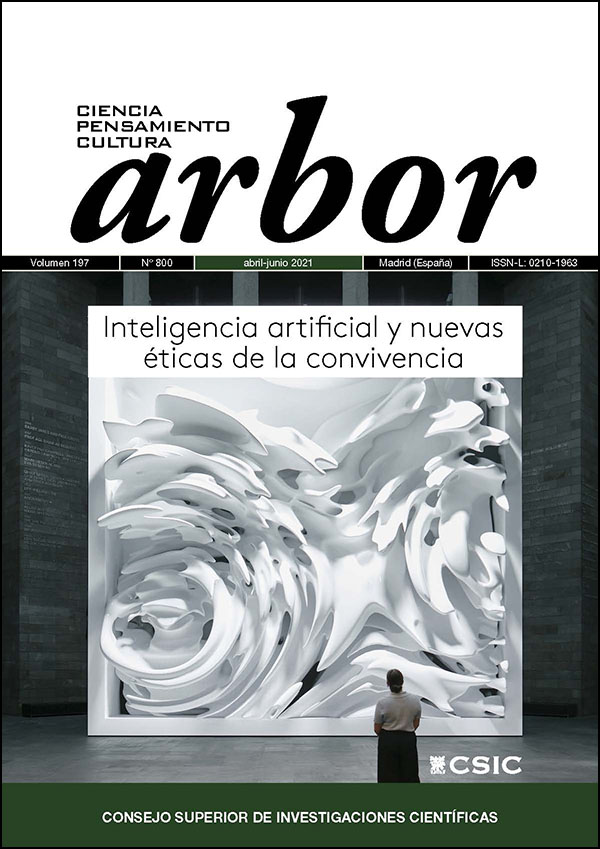Colorear por números: la tecnología digital y el arte de vivir
DOI:
https://doi.org/10.3989/arbor.2021.800004Palabras clave:
Tecnología, inteligencia artificial, experiencia, fenomenología, arteResumen
Lo digital descansa en la computación. La programación utiliza algoritmos. Los algoritmos son el conjunto de reglas que resuelven problemas en un número finito de pasos. En este sentido, el mundo digital está regido por cantidades, números, reglas fijas. El grado de libertad parece muy limitado. Por el contrario, la actividad artística y la creatividad descansan en la apertura, la libertad y en experiencias cualitativas. Estas experiencias no solo son vitales para la expresión artística, sino para la vida cotidiana. Los mundos-vitales tecnológicos tal como se representan en tecnologías actuales (por ejemplo, en las casas inteligentes o en la conducción automática) o en la ciencia ficción no parecen dar cabida a estas estructuras abiertas. La filosofía de la tecnología está dividida: muchos sostienen que la tecnología determina en gran medida la cognición humana (como Mark B. N. Hansen, Bernard Stiegle) y, consiguientemente, subordina la cognición humana a las organizaciones maquinales. Otros adoptan una aproximación diferente y reflexionan sobre el potencial creativo de las nuevas tecnologías (Erin Mannig, Jaime del Val).
Este artículo discute teorías que abordan la relación humano-máquina en tanto que estructuras complejas que van más allá de la visión distópica del ser humano siendo trascendido o incorporado por la tecnología. Estas aproximaciones son centrales para discutir el futuro del ser humano y la conformación político-cultural de los mundos vitales. Para entender cómo las relaciones humano-máquina pueden considerarse como procesos abiertos y creativos, presento narrativas de cognición corporalizada, ejemplos artísticos de estrategias de performance con sistemas algorítmicos, y finalmente engarzo estos aspectos en un panorama más amplio sobre la conceptualización de la tecnología y la vida humana como un continuo, en vez de una sostenida oposición o un estar determinado por el otro.
Descargas
Citas
Barad, Karen (2007). Meeting the Universe Halfway: Quantum Physics and the Entanglement of Matter and Meaning. Durham: Duke University Press. https://doi.org/10.2307/j.ctv12101zq
Coeckelbergh, Mark (2019). Technology Games/Gender Games. From Wittgenstein's Toolbox and Language Games to Gendered Robots and Biased Artificial Intelligence. https://doi.org/10.1007/978-3-476-04967-4_2
In: Janina Loh, Mark Coeckelbergh (eds.). Techno:Phil - Aktuelle Herausforderungen der Technikphilosophie (Vol 2). Stuttgart: J. B. Metzler, pp. 27-38.
Coeckelbergh, Mark (2020). Technoperformances: Using Metaphors from the Performance Arts for a Postphenomenology and Posthermeneutics of Technology Use. AI & SOCIETY, 35: pp. 1-12. https://doi.org/10.1007/s00146-019-00926-7
Förster, Yvonne (2020a). Aesthetics of the Past and the Future, Human Life within Changing Environments. In Zoltan Somhegyi, Max Ryynänen (eds.). Aesthetics in Dialogue. Bern: Peter Lang, pp. 237-250.
Förster, Yvonne (2020b). Ecological Subjectivity vs. Brainhood: Why Experience Matters. In Markus Mühling (ed.). Perceiving Truth and Value Phenomenological Deliberations on Ethical Perception. Göttingen: Vandenhoeck&Ruprecht, pp. 63-76. https://doi.org/10.13109/9783666573200.63 PMid:31330456
Förster, Yvonne (2016). Singularities and Superintelligence: Transcending the Human in Contemporary Cinema. Trans-Humanities, 9 (3): 33-50. https://doi.org/10.1353/trh.2016.0020
Gibson, James J. (1979/1986). The Ecological Approach to Visual Perception. Boston: Houghton Mifflin.
Hansen, Mark B. N. (2012). Engineering Preindividual Potentiality: Technics, Transindividuation, and 21st-Century Media. SubStance, 129 (41.3): 32-59. https://doi.org/10.1353/sub.2012.0025
Hayles, Katherine N. (2012). How We Think: Digital Media and Contemporary Technogenesis. Chicago: University of Chicago Press. https://doi.org/10.7208/chicago/9780226321370.001.0001
Heidegger, Martin (1977). The Question Concerning Technology and Other Essays. New York, London: Garland Publishing Inc.
Husserl, Edmund, (1936/1970). The Crisis of European Sciences and Transcendental Phenomenology: An Introduction to Phenomenological Philosophy. Evanston: Northwestern University Press.
Ihde, Don (2001). Bodies in Technology. Minneapolis, London: University of Minnesota Press.
Ingold, Timothy (2014). The Creativity of Undergoing. Pragmatics and Cognition, 22 (1): 124-139. https://doi.org/10.1075/pc.22.1.07ing
Kurzweil, Ray (2006). The Singularity Is Near: When Humans Transcend Biology. New York: Penguin Books.
Loh, Janina (2018). Trans- und Posthumanismus zu Einführung. Hamburg: Junius.
Manning, Erin (2016). The Minor Gesture. Durham: Duke University Press. https://doi.org/10.2307/j.ctv111jhg1
Manovich, Lev (2020). Computer Vision, Human Senses, and Language of Art. AI & Society: 1-8. https://doi.org/10.1007/s00146-020-01094-9
McLuhan, Marshall (1964/1994). Understanding Media, The Extensions of Man. Cambridge (MA): MIT Press.
Merleau-Ponty, Maurice (1966/2014). Phenomenology of Perception. Abingdon, New York: Routledge. https://doi.org/10.4324/9780203720714
Merleau-Ponty, Maurice (1963). The Structure of Behavior. London: Beacon Press.
Merleau-Ponty, Maurice (1969). The Visible and the Invisible. Evanston: Northwestern University Studies.
Seibt, Johanna (2020). Sociomorphing, Not Anthropomorphizing: Towards a Typology of Experienced Sociality. In Marko Nørskov, Johanna Seibt, Oliver Santiago Quick (eds.). Culturally Sustainable Social Robotics-Proceedings of Robophilosophy. Amsterdam: IOS Press, pp. 51-67. https://doi.org/10.3233/FAIA200900
Stiegler, Bernard (1998). Technics and Time, 1: The Fault of Epimetheus. Stanford: Stanford University Press.
Sudmann, Andreas (2020). Künstliche neuronale Netzwerke als Black Box: Verfahren der Explainable AI. Medienwissenschaftliche Perspektiven. In: Peter Klimczak, Christer Petersen, Samuel Breidenbach (eds.). Maschinen der Kommunikation. Interdisziplinäre Perspektiven auf Technik und Gesellschaft im digitalen Zeitalter. Wiesbaden: Springer, pp. 189-199. https://doi.org/10.1007/978-3-658-27852-6_10
Uexküll, Jakob Johann von (1909) Umwelt und Innenwelt der Tiere. Berlin: Springer.
Varela, Francisco, Thompson, Evan and Rosch, Eleanor (1993). The Embodied Mind. Cognitive Science and Human Experience. Cambridge (MA): The MIT Press.
Verbeek, Peter-Paul (2005). What Things Do: Philosophical Reflections on Technology, Agency, and Design. University Park: Pennsylvania State University Press. https://doi.org/10.5325/j.ctv14gp4w7
Yan Zheng, Caroline (2017). Machinising Humans and Humanising Machines: Emotional Relationships Mediated by Technology and Material Experience. In Susan Broadhurst, Sarah Price (eds.). Digital Bodies: Creativity and Technology in the Arts and Humanities. London: Palgrave Macmillan, pp. 111-127. https://doi.org/10.1057/978-1-349-95241-0_8
Publicado
Cómo citar
Número
Sección
Licencia
Derechos de autor 2021 Consejo Superior de Investigaciones Científicas (CSIC)

Esta obra está bajo una licencia internacional Creative Commons Atribución 4.0.
© CSIC. Los originales publicados en las ediciones impresa y electrónica de esta Revista son propiedad del Consejo Superior de Investigaciones Científicas, siendo necesario citar la procedencia en cualquier reproducción parcial o total.Salvo indicación contraria, todos los contenidos de la edición electrónica se distribuyen bajo una licencia de uso y distribución “Creative Commons Reconocimiento 4.0 Internacional ” (CC BY 4.0). Puede consultar desde aquí la versión informativa y el texto legal de la licencia. Esta circunstancia ha de hacerse constar expresamente de esta forma cuando sea necesario.
No se autoriza el depósito en repositorios, páginas web personales o similares de cualquier otra versión distinta a la publicada por el editor.














